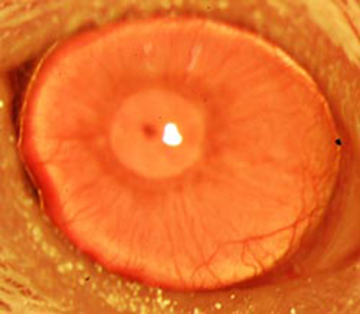 Harvard Medical School researchers have identified a way to enhance regrowth of human corneal tissue to restore vision, using a molecule known as ABCB5 that acts as a marker for hard-to-find limbal stem cells. This work, a collaboration between the Massachusetts Eye and Ear/Schepens Eye Research Institute (Mass. Eye and Ear), Boston Children’s Hospital, Brigham and Women’s Hospital and the VA Boston Healthcare System, provides promise to burn victims, victims of chemical injury and others with damaging eye diseases.
Harvard Medical School researchers have identified a way to enhance regrowth of human corneal tissue to restore vision, using a molecule known as ABCB5 that acts as a marker for hard-to-find limbal stem cells. This work, a collaboration between the Massachusetts Eye and Ear/Schepens Eye Research Institute (Mass. Eye and Ear), Boston Children’s Hospital, Brigham and Women’s Hospital and the VA Boston Healthcare System, provides promise to burn victims, victims of chemical injury and others with damaging eye diseases.
The research, published this week in Nature, is also one of the first-known examples of constructing a tissue from an adult-derived human stem cell.
Limbal stem cells reside in the eye’s basal limbal epithelium, or limbus, and help maintain and regenerate corneal tissue. Their loss due to injury or disease is one of the leading causes of blindness. In the past, tissue or cell transplants have been used to help the cornea regenerate, but it was unknown whether there were actual limbal stem cells in the grafts, or how many, and the outcomes were not consistent.
In this study, researchers were able to use antibodies detecting ABCB5 to zero in on the stem cells in tissue from deceased human donors and use them to regrow anatomically correct, fully functional human corneas in mice.
“Limbal stem cells are very rare, and successful transplants are dependent on these rare cells,” said Bruce Ksander, HMS associate professor of ophthalmology Mass. Eye and Ear, co-lead author on the study with post-doctoral fellow Paraskevi Kolovou. “This finding will now make it much easier to restore the corneal surface. It’s a very good example of basic research moving quickly to a translational application.”
ABCB5 was originally discovered in the lab of Markus Frank, HMS assistant professor of pediatrics at Boston Children’s Hospital, and Natasha Frank, HMS assistant professor of medicine at VA Boston Healthcare System and Brigham and Women’s Hospital, co-senior investigators on the study, as being produced in tissue precursor cells in human skin and intestine. In the new work, using a mouse model developed by the Frank lab, they found that ABCB5 also occurs in limbal stem cells and is required for their maintenance and survival, and for corneal development and repair. Mice lacking a functional ABCB5 gene lost their populations of limbal stem cells, and their corneas healed poorly after injury.
“ABCB5 allows limbal stem cells to survive, protecting them from apoptosis [programmed cell death],” said Markus Frank.
“The mouse model allowed us for the first time to understand the role of ABCB5 in normal development, and should be very important to the stem cell field in general,” according to Natasha Frank.
Markus Frank is working with biopharmaceutical industry to develop a clinical-grade ABCB5 antibody that would meet U.S. regulatory approvals. “A single lab cannot do a study like this,” said Natasha Frank, also affiliated with the Harvard Stem Cell Institute. “It integrates genetics, knockout mice, antibodies, transplantation—a lot of technical expertise that we were lucky came together in a very nice way.”
The research was supported by the National Institute of Neurological Disorders and Stroke (grant K08NS051349), the Veterans Administration (BLR&D 1I01BX000516 and VA RR&D 1I01RX000989), the Harvard Stem Cell Institute, the National Cancer Institute (R01CA113796, R01CA158467, R01CA138231), the Department of Defense (PR0332453), the National Institutes of Health (R01EY018624, P30EY014801, R01EY021768, R01CA138231, R01EB017274, U01HL100402, P41EB015903 and NIH New Innovator Award DP2OD007483), the Corley Research Foundation, the Western Pennsylvania Medical Eye Bank Core Grant for Vision Research (EY08098), the Howard Hughes Medical Institute and the Life Sciences Research Foundation.
Adapted from a Mass. Eye and Ear news release.


